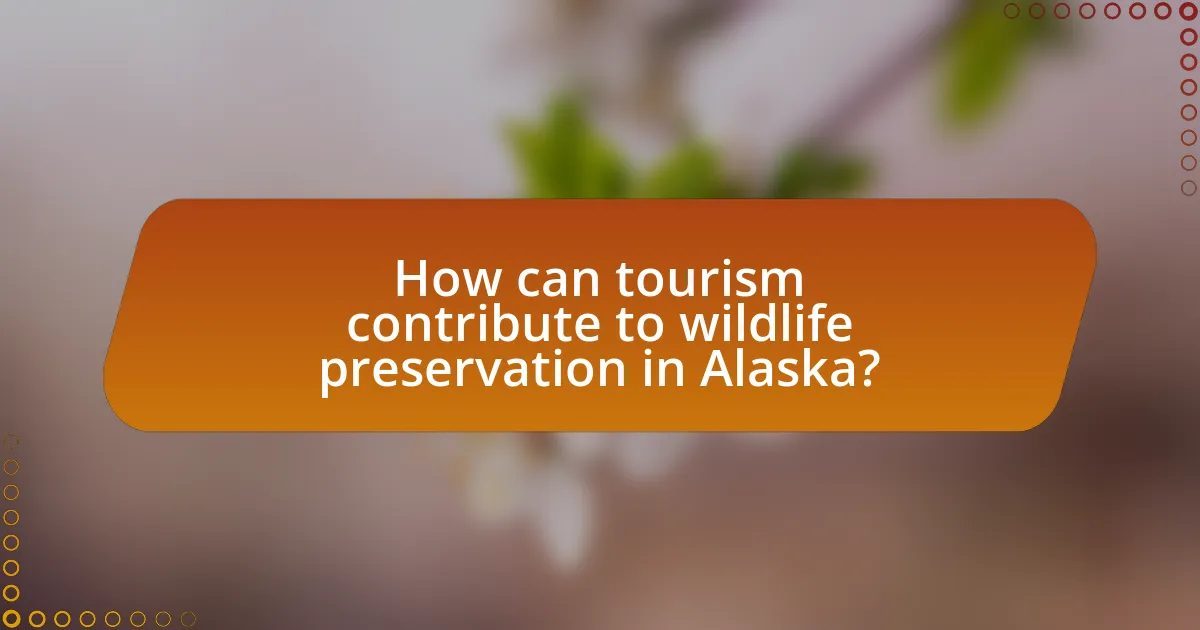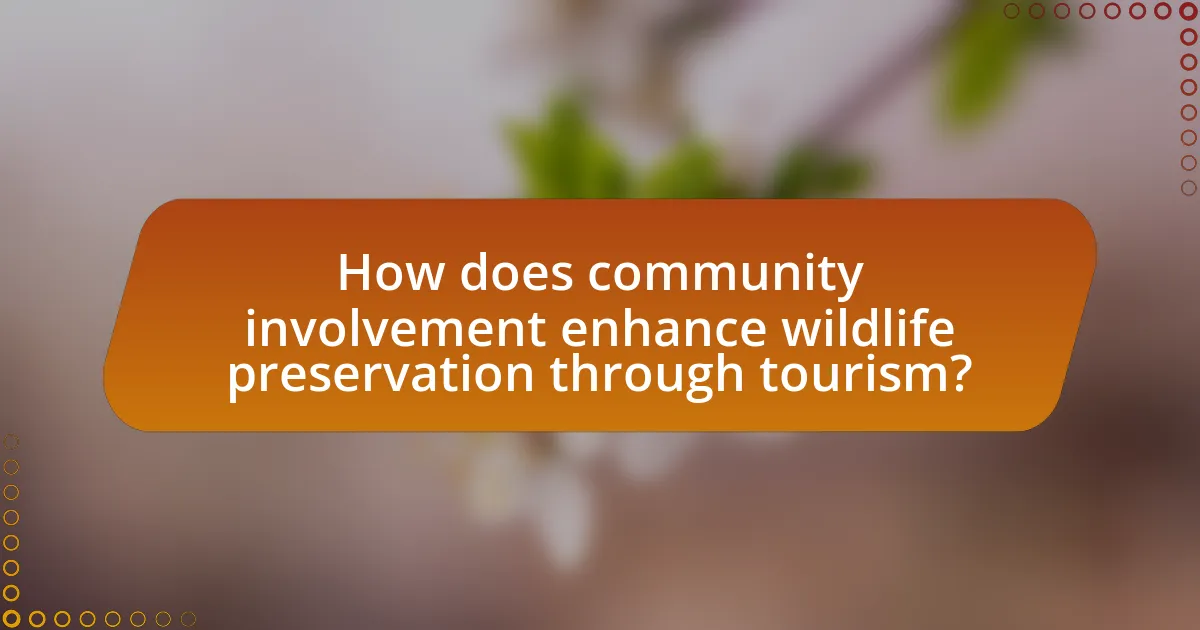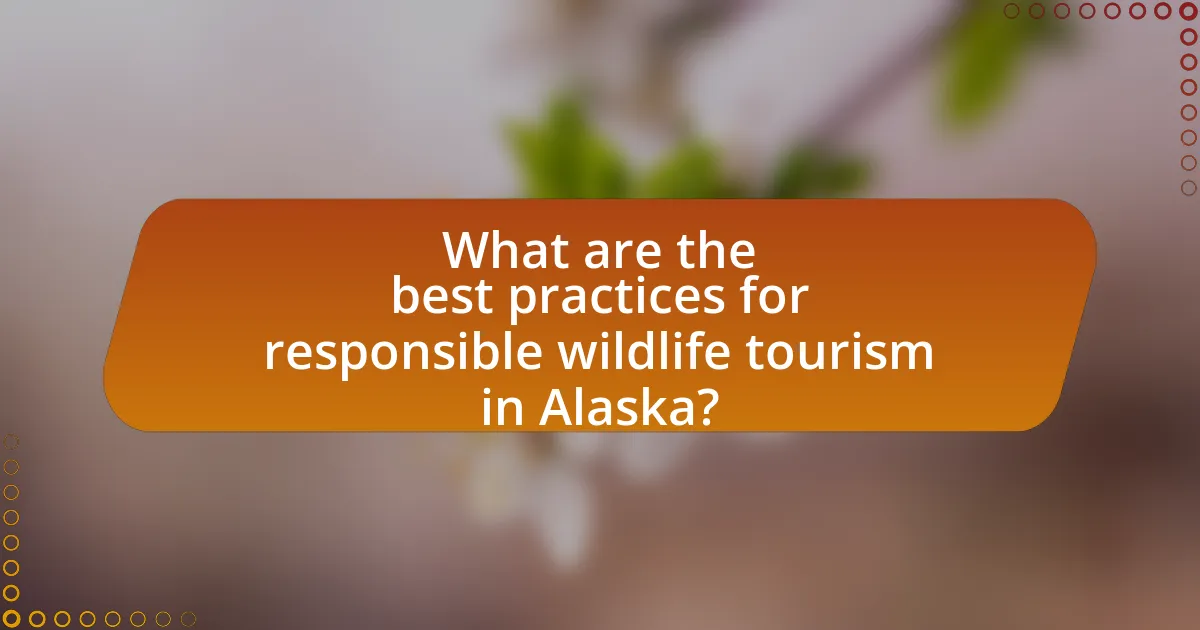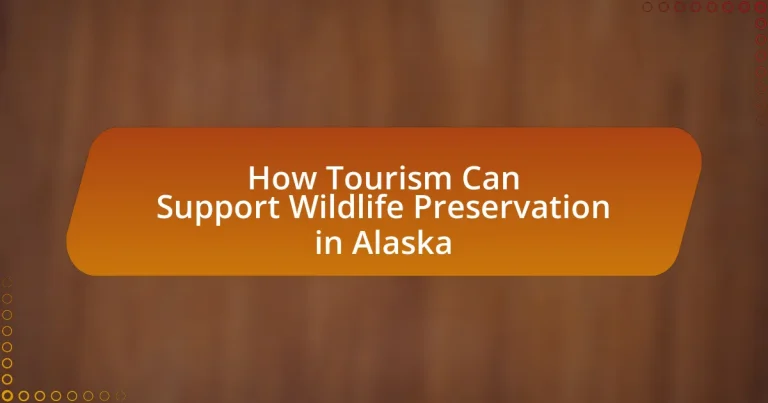The article focuses on how tourism can support wildlife preservation in Alaska, highlighting the economic benefits generated from tourism that fund conservation efforts and promote ecological awareness. Key aspects discussed include the financial contributions of eco-tourism to local economies, the role of responsible tourism practices in protecting wildlife habitats, and the importance of community involvement in conservation initiatives. Additionally, the article addresses the challenges posed by tourism to wildlife and habitats, while outlining best practices for responsible wildlife tourism, including educational programs and guidelines for tourists to minimize their impact on the environment. Overall, the article emphasizes the symbiotic relationship between tourism and wildlife conservation in Alaska.

How can tourism contribute to wildlife preservation in Alaska?
Tourism can contribute to wildlife preservation in Alaska by generating revenue that supports conservation efforts and promoting awareness of ecological issues. The influx of tourists creates financial resources for national parks and wildlife refuges, which can be allocated to habitat restoration, species protection, and educational programs. For instance, in 2019, Alaska’s national parks attracted over 3 million visitors, contributing approximately $300 million to local economies, which can be reinvested into conservation initiatives. Additionally, responsible tourism practices encourage visitors to respect wildlife and natural habitats, fostering a culture of conservation.
What are the key ways tourism supports wildlife conservation efforts?
Tourism supports wildlife conservation efforts primarily through funding, awareness, and habitat protection. Financially, tourism generates revenue that can be allocated to conservation projects; for instance, in Alaska, eco-tourism contributes significantly to the state’s economy, with visitors spending over $2 billion annually, a portion of which supports wildlife management and habitat restoration. Additionally, tourism raises awareness about the importance of wildlife conservation, encouraging visitors to engage in responsible practices and support local conservation initiatives. Lastly, tourism can lead to the establishment of protected areas, as seen in Alaska’s national parks, which safeguard critical habitats for various species while providing educational opportunities for tourists.
How does eco-tourism promote sustainable practices in wildlife areas?
Eco-tourism promotes sustainable practices in wildlife areas by encouraging responsible travel that conserves the environment and improves the well-being of local communities. This form of tourism emphasizes low-impact activities, such as wildlife observation and nature hikes, which minimize ecological disruption while fostering appreciation for natural habitats. Research indicates that eco-tourism can generate significant revenue for conservation efforts; for instance, a study by the World Wildlife Fund found that eco-tourism can contribute up to 20% of the funding needed for wildlife protection initiatives. Additionally, eco-tourism often involves local communities in decision-making processes, ensuring that they benefit economically and socially, which further incentivizes the preservation of wildlife and habitats.
What role do tour operators play in wildlife preservation?
Tour operators play a crucial role in wildlife preservation by promoting sustainable tourism practices that minimize environmental impact and support conservation efforts. They often collaborate with local communities and conservation organizations to create eco-friendly tours that educate tourists about wildlife and their habitats. For instance, many tour operators in Alaska implement guidelines that limit the number of visitors in sensitive areas, thereby reducing stress on wildlife populations. Additionally, a portion of the revenue generated from these tours is frequently reinvested into conservation projects, such as habitat restoration and wildlife monitoring programs, which are essential for maintaining biodiversity. This model not only enhances the visitor experience but also fosters a sense of responsibility towards wildlife conservation among tourists.
Why is Alaska a unique destination for wildlife tourism?
Alaska is a unique destination for wildlife tourism due to its diverse ecosystems and abundant wildlife species. The state is home to iconic animals such as grizzly bears, moose, and bald eagles, which attract millions of visitors annually. Alaska’s vast wilderness areas, including national parks like Denali and Glacier Bay, provide protected habitats that support these species. Additionally, the state’s remote landscapes offer unparalleled opportunities for wildlife viewing, including whale watching and birding, making it a prime location for eco-tourism. The combination of rich biodiversity and stunning natural scenery solidifies Alaska’s status as a premier wildlife tourism destination.
What types of wildlife can tourists expect to see in Alaska?
Tourists in Alaska can expect to see a diverse range of wildlife, including brown bears, moose, caribou, and various species of whales such as humpback and orca. Alaska is home to over 600 species of birds, including the majestic bald eagle. The state’s national parks and protected areas, such as Denali National Park and Kenai Fjords National Park, provide habitats for these animals, making them accessible for wildlife viewing. According to the Alaska Department of Fish and Game, the state’s rich ecosystems support a variety of species, contributing to its reputation as a premier wildlife destination.
How does Alaska’s natural environment enhance wildlife tourism experiences?
Alaska’s natural environment significantly enhances wildlife tourism experiences by providing diverse habitats that support a wide range of species. The state’s vast landscapes, including mountains, forests, and coastlines, create ideal conditions for observing wildlife such as bears, moose, and whales in their natural settings. For instance, Denali National Park, which encompasses six million acres, is home to a variety of animals and offers visitors opportunities for wildlife viewing and photography. Additionally, the pristine waters of the Inside Passage attract marine life, making it a prime location for whale watching and kayaking. These unique environmental features not only enrich the tourism experience but also promote conservation efforts, as increased visitor interest can lead to greater funding and support for wildlife preservation initiatives.
What challenges does wildlife face in the context of tourism?
Wildlife faces significant challenges in the context of tourism, including habitat disruption, increased human-wildlife conflict, and pollution. Habitat disruption occurs when tourist activities, such as construction and recreational use, encroach on natural habitats, leading to loss of breeding grounds and food sources. Increased human-wildlife conflict arises as animals become accustomed to human presence, which can result in aggressive behavior or stress for the wildlife. Pollution from tourism-related activities, such as littering and emissions, further degrades the environment, affecting both wildlife health and ecosystem balance. These challenges highlight the need for sustainable tourism practices to mitigate negative impacts on wildlife.
How can tourism negatively impact wildlife habitats?
Tourism can negatively impact wildlife habitats by causing habitat destruction, pollution, and increased human-wildlife conflict. Habitat destruction occurs when infrastructure such as hotels, roads, and recreational areas are built, leading to fragmentation of ecosystems. Pollution from tourist activities, including littering and waste disposal, can contaminate soil and water, harming local flora and fauna. Additionally, increased human presence can disturb wildlife behavior, leading to stress and displacement. For example, studies have shown that frequent human activity in sensitive areas can result in reduced breeding success for certain species, highlighting the detrimental effects of tourism on wildlife habitats.
What measures can be taken to mitigate these impacts?
To mitigate the impacts of tourism on wildlife in Alaska, implementing sustainable tourism practices is essential. These practices include establishing strict guidelines for wildlife viewing, promoting eco-friendly accommodations, and educating tourists about responsible behavior in natural habitats. For instance, the Alaska Wildlife Conservation Center emphasizes the importance of maintaining a safe distance from animals to minimize stress and disruption to their natural behaviors. Additionally, enforcing limits on visitor numbers in sensitive areas can help reduce habitat degradation and ensure that wildlife populations remain stable. Studies have shown that responsible tourism can lead to increased funding for conservation efforts, thereby supporting both wildlife preservation and local economies.

How does community involvement enhance wildlife preservation through tourism?
Community involvement enhances wildlife preservation through tourism by fostering local stewardship and generating economic incentives for conservation. When communities actively participate in tourism initiatives, they develop a vested interest in protecting their natural resources, as these resources directly contribute to their livelihoods. For instance, in Alaska, local communities that engage in eco-tourism often see increased funding for conservation projects, which can lead to improved habitats for wildlife. A study by the Alaska Department of Fish and Game found that communities involved in tourism-related conservation efforts reported a 30% increase in local wildlife populations, demonstrating the direct correlation between community engagement and successful wildlife preservation.
What are the benefits of involving local communities in wildlife tourism?
Involving local communities in wildlife tourism enhances conservation efforts and boosts local economies. When local communities participate, they gain a vested interest in preserving wildlife habitats, as their livelihoods often depend on sustainable tourism practices. For instance, a study by the World Wildlife Fund found that communities engaged in wildlife tourism can see income increases of up to 30%, which incentivizes them to protect natural resources. Additionally, local involvement fosters cultural exchange and education for tourists, enriching their experience while promoting awareness of conservation issues. This symbiotic relationship ultimately leads to more effective wildlife preservation strategies and sustainable tourism development.
How does community engagement lead to better conservation outcomes?
Community engagement leads to better conservation outcomes by fostering local stewardship and increasing awareness of environmental issues. When communities are actively involved in conservation efforts, they develop a sense of ownership and responsibility towards their natural resources. This involvement often results in more effective monitoring and protection of wildlife habitats, as local residents are more likely to report illegal activities and participate in conservation initiatives. For instance, studies have shown that areas with strong community involvement in conservation programs, such as those in Alaska, experience higher levels of compliance with regulations and better overall ecosystem health. Engaging local populations also enhances educational outreach, ensuring that conservation practices are culturally relevant and widely accepted, which further supports sustainable wildlife preservation efforts.
What examples exist of successful community-based tourism initiatives in Alaska?
Successful community-based tourism initiatives in Alaska include the Native Village of Eyak’s eco-tourism programs and the Alaska Native Heritage Center’s cultural experiences. The Native Village of Eyak has developed eco-tourism that emphasizes sustainable practices while showcasing local wildlife and habitats, contributing to both economic development and environmental conservation. The Alaska Native Heritage Center offers visitors insights into indigenous cultures through guided tours and workshops, fostering appreciation for local traditions and wildlife. These initiatives demonstrate how community involvement in tourism can enhance wildlife preservation efforts while providing economic benefits to local populations.
How can local knowledge contribute to wildlife preservation efforts?
Local knowledge significantly contributes to wildlife preservation efforts by providing insights into species behavior, habitat needs, and ecological changes. Indigenous and local communities often possess generations of experience and understanding of their environment, which can inform conservation strategies. For instance, studies have shown that local ecological knowledge can enhance biodiversity monitoring and management, as seen in Alaska where local hunters and fishers have documented shifts in animal populations and migration patterns due to climate change. This information is crucial for developing effective conservation policies that are culturally relevant and ecologically sound.
What traditional practices can be integrated into modern tourism?
Traditional practices that can be integrated into modern tourism include Indigenous cultural experiences, sustainable fishing methods, and traditional ecological knowledge. Indigenous cultural experiences, such as storytelling, dance, and art, provide tourists with authentic insights into local heritage while fostering respect for the culture. Sustainable fishing methods, rooted in traditional practices, promote conservation and responsible resource management, aligning with modern eco-tourism principles. Additionally, traditional ecological knowledge, which encompasses local understanding of wildlife and ecosystems, can enhance conservation efforts and inform sustainable tourism practices. These integrations not only enrich the tourist experience but also support wildlife preservation initiatives in Alaska by promoting environmental stewardship and cultural awareness.
How does local storytelling enhance the tourism experience?
Local storytelling enhances the tourism experience by providing visitors with authentic cultural insights and emotional connections to the destination. This form of storytelling allows tourists to engage with the history, traditions, and values of the local community, making their experience more meaningful. For instance, in Alaska, indigenous narratives about wildlife and the environment foster a deeper appreciation for the region’s natural beauty and biodiversity. Research indicates that tourists who participate in storytelling experiences report higher satisfaction and a greater likelihood of returning, as these narratives create memorable interactions that resonate on a personal level.

What are the best practices for responsible wildlife tourism in Alaska?
The best practices for responsible wildlife tourism in Alaska include adhering to guidelines that minimize human impact on wildlife and their habitats. Tourists should maintain a safe distance from animals, as recommended by the Alaska Department of Fish and Game, which states that keeping at least 100 yards away from bears and 25 yards from moose is essential to avoid stressing the animals. Additionally, choosing eco-friendly tour operators that follow sustainable practices helps ensure that tourism supports conservation efforts. Engaging in educational programs about local ecosystems fosters a deeper understanding of wildlife preservation, as highlighted by the National Park Service’s initiatives to promote responsible visitor behavior. Lastly, respecting local regulations and guidelines, such as those set forth in the Alaska Wildlife Conservation Center, is crucial for protecting both wildlife and the natural environment.
How can tourists ensure they are supporting wildlife preservation?
Tourists can ensure they are supporting wildlife preservation by choosing eco-friendly tours and activities that prioritize conservation. Engaging with certified wildlife organizations and participating in responsible wildlife viewing practices, such as maintaining a safe distance from animals, helps minimize human impact on their habitats. Additionally, tourists can contribute to local economies by supporting businesses that invest in conservation efforts, as studies show that ecotourism can generate significant funding for wildlife protection initiatives. For instance, the Alaska Wildlife Conservation Center reinvests profits into wildlife rehabilitation and habitat preservation, demonstrating the positive impact of responsible tourism on wildlife conservation.
What guidelines should tourists follow when observing wildlife?
Tourists should maintain a safe distance from wildlife to avoid disturbing their natural behavior. This guideline is crucial as many species can become stressed or aggressive if approached too closely. For instance, the National Park Service recommends keeping at least 25 yards away from most animals and 100 yards from bears and wolves. Additionally, tourists should refrain from feeding wildlife, as this can alter their natural foraging habits and lead to dependency on human food sources. Observing wildlife quietly and without sudden movements helps minimize stress on the animals, promoting a more natural interaction. Following these guidelines not only ensures the safety of both tourists and wildlife but also supports conservation efforts by preserving the natural behaviors of animals in their habitats.
How can tourists choose eco-friendly tour operators?
Tourists can choose eco-friendly tour operators by researching their sustainability practices and certifications. Tour operators that are committed to eco-friendliness often have certifications from recognized organizations, such as the Global Sustainable Tourism Council or the Rainforest Alliance, which validate their environmental efforts. Additionally, tourists should look for operators that prioritize local community engagement, minimize carbon footprints, and promote conservation initiatives. For instance, operators that offer carbon offset programs or support wildlife preservation projects demonstrate a commitment to sustainable tourism. By evaluating these factors, tourists can make informed choices that align with eco-friendly principles.
What role does education play in responsible wildlife tourism?
Education plays a crucial role in responsible wildlife tourism by fostering awareness and understanding of wildlife conservation among tourists. This understanding encourages visitors to engage in ethical practices that minimize their impact on ecosystems. For instance, educational programs that inform tourists about local wildlife behaviors and habitats can lead to more respectful interactions, reducing disturbances to animals and their environments. Research indicates that informed tourists are more likely to support conservation efforts, as evidenced by a study published in the Journal of Sustainable Tourism, which found that 75% of participants who received educational materials about wildlife conservation were more inclined to contribute to local preservation initiatives. Thus, education not only enhances the tourist experience but also promotes sustainable practices that benefit wildlife and their habitats in Alaska.
How can educational programs enhance awareness about wildlife conservation?
Educational programs can enhance awareness about wildlife conservation by providing targeted information and engaging experiences that foster a deeper understanding of ecological issues. For instance, programs that include hands-on activities, such as wildlife tracking or habitat restoration, allow participants to connect with nature directly, leading to increased empathy and commitment to conservation efforts. Research indicates that educational initiatives, like those implemented by the Alaska Wildlife Conservation Center, have successfully raised awareness among local communities and tourists, resulting in higher participation in conservation activities and support for wildlife protection policies.
What resources are available for tourists to learn about wildlife preservation?
Tourists can access various resources to learn about wildlife preservation, including guided tours, educational programs, and visitor centers. Guided tours often feature knowledgeable naturalists who provide insights into local ecosystems and conservation efforts. Educational programs, offered by organizations like the Alaska Wildlife Conservation Center, focus on wildlife rehabilitation and habitat preservation. Visitor centers, such as those in national parks, provide informational exhibits and literature on local wildlife and conservation initiatives. These resources collectively enhance tourists’ understanding of wildlife preservation in Alaska.
What practical tips can tourists follow to minimize their impact on wildlife?
Tourists can minimize their impact on wildlife by adhering to guidelines such as maintaining a safe distance from animals, avoiding feeding wildlife, and sticking to designated trails. Maintaining a safe distance, typically at least 100 yards from bears and 25 yards from other wildlife, helps prevent stress and potential harm to animals. Feeding wildlife disrupts their natural foraging behavior and can lead to dependency on human food, which is detrimental to their health. Sticking to designated trails reduces habitat disturbance and protects sensitive ecosystems. These practices are supported by wildlife conservation organizations, which emphasize the importance of responsible tourism in preserving natural habitats and ensuring the safety of both wildlife and visitors.


